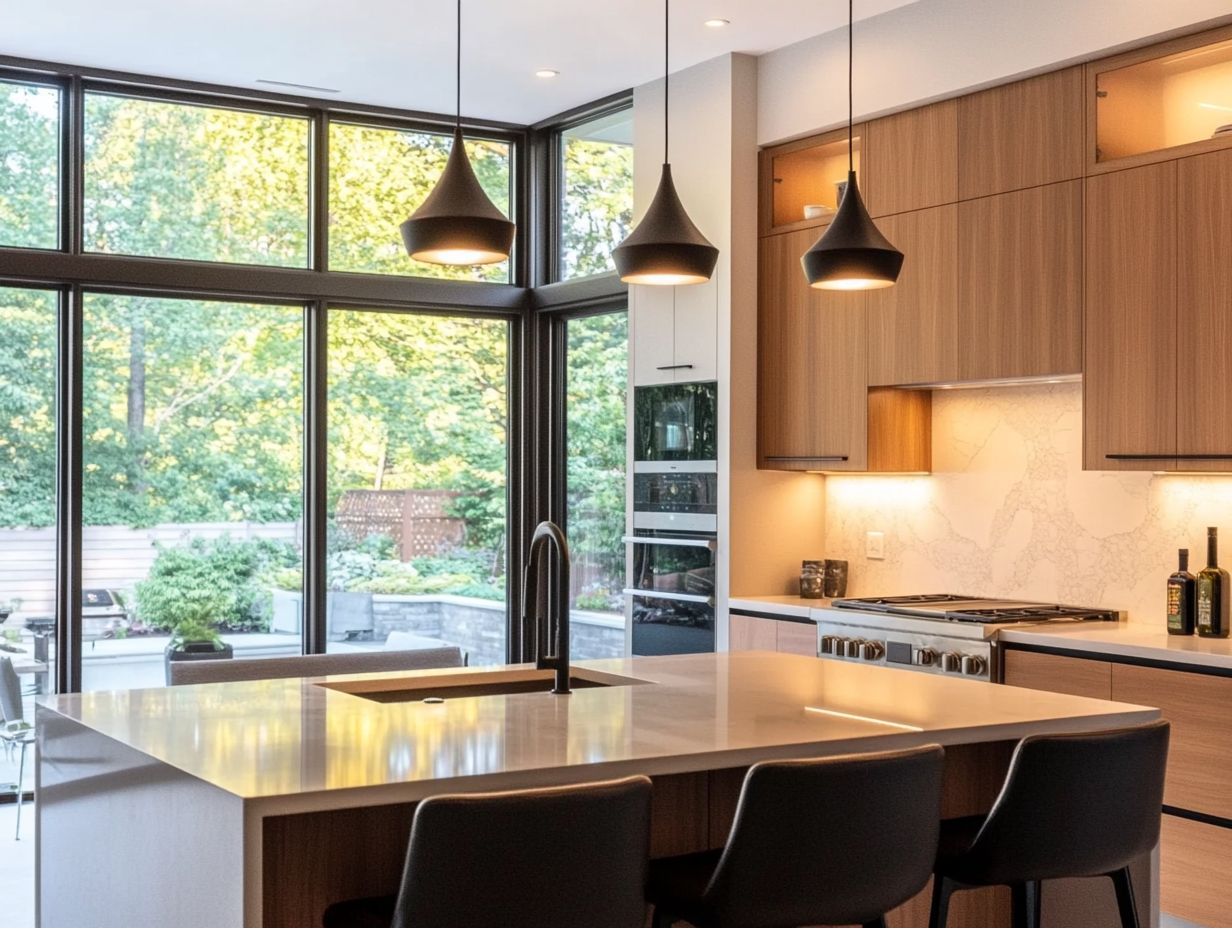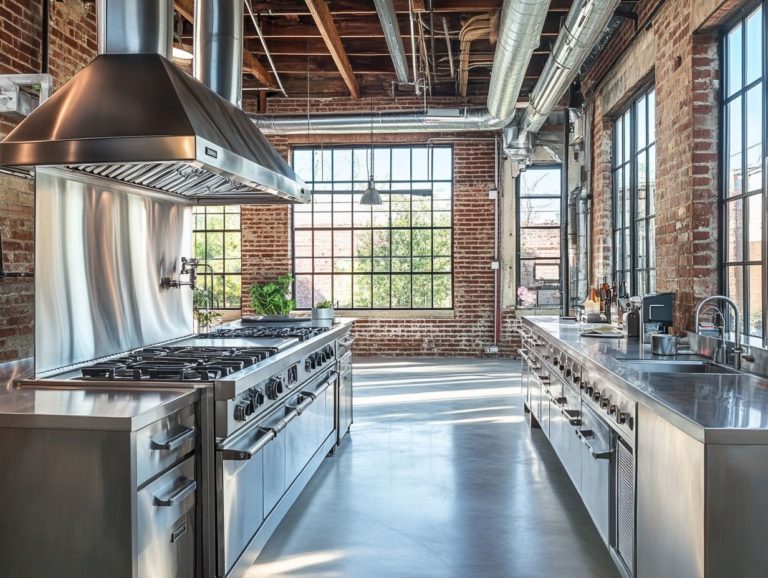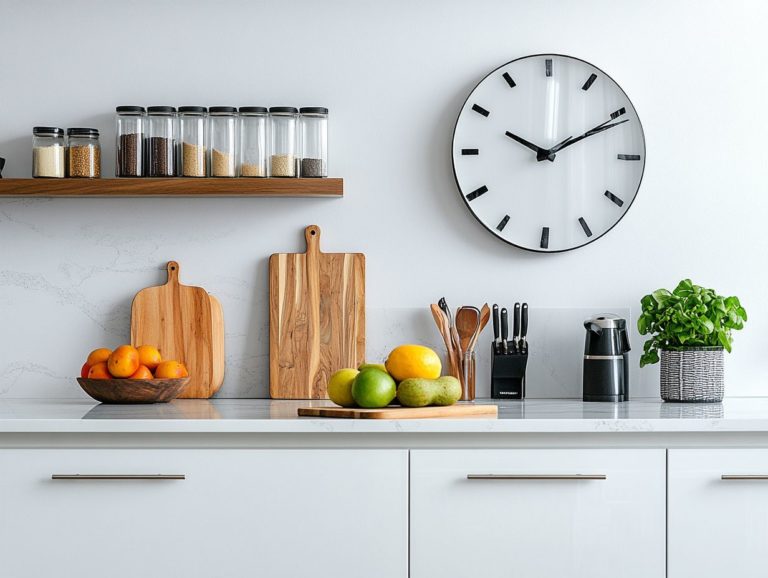The Impact of Lighting on Kitchen Design
Lighting holds the key to exceptional kitchen design. A well-illuminated kitchen elevates your culinary adventures. It also creates a welcoming atmosphere for social gatherings.
In this article, you will discover the various types of lighting—task, ambient, and accent—that can refresh your kitchen. You’ll also find essential factors to consider, common pitfalls to sidestep, and practical strategies for optimizing both artificial and natural light.
Let’s dive in and transform your kitchen with stunning lighting!
Contents
- Key Takeaways:
- The Role of Lighting in Kitchen Design
- Types of Lighting for Kitchen Design
- Factors to Consider in Kitchen Lighting Design
- Common Lighting Mistakes to Avoid
- Tips for Maximizing Lighting in the Kitchen
- Frequently Asked Questions
- What is the impact of lighting on kitchen design?
- How does lighting affect the functionality of a kitchen?
- What are the different types of lighting that can be used in kitchen design?
- How can lighting create a specific ambiance in a kitchen?
- What are some key design elements that can be highlighted with lighting in a kitchen?
- How do I choose the right lighting for my kitchen design?
Key Takeaways:

Proper lighting is crucial in creating a functional and aesthetically pleasing kitchen space. Incorporating a combination of task, ambient, and accent lighting can enhance the overall design and functionality of a kitchen. Consider the layout, functionality, and style of your kitchen when planning the lighting design to avoid common mistakes and maximize the impact of lighting.
The Role of Lighting in Kitchen Design
Lighting is essential in kitchen design. It elevates the cooking space into an inviting and functional area that enhances both its visual appeal and practical use.
By integrating a variety of lighting solutions—think ambient, task, and accent lighting—you can craft a layered scheme. This scheme complements your unique kitchen layout while fostering a warm atmosphere perfect for family gatherings and safe cooking, particularly during those chilly winter months.
Kitchen experts stress the importance of choosing the right fixtures and light temperatures. This choice is vital in creating the ideal kitchen ambiance.
Why Lighting is Important in the Kitchen
Lighting in your kitchen is essential for several compelling reasons. It enhances the aesthetic appeal of the space and ensures safe cooking practices during various tasks.
Effective kitchen lighting plays a vital role in creating a comfortable ambiance. It fosters creativity and productivity.
For example, pendant lights above your island provide focused illumination for meal preparation. They also infuse a decorative flair into the environment. Choosing energy-efficient LED solutions can significantly reduce your utility bills while offering versatile brightness levels to suit your needs.
Well-placed task lighting, such as under-cabinet fixtures, works wonders in eliminating shadows. This makes it safer to handle sharp instruments.
The right lighting can truly transform your interaction with the kitchen. It strikes a perfect balance between safety, efficiency, and mood.
Types of Lighting for Kitchen Design
Understanding the different types of lighting is crucial for crafting a kitchen that is not only functional but also visually stunning.
In the realm of kitchen design, you’ll primarily rely on three types of lighting: ambient lighting, task lighting, and accent lighting. Each type serves a distinct purpose in enhancing your cooking space.
By adopting a layered lighting strategy, you can effectively establish lighting zones tailored to various kitchen tasks and moods. Incorporating smart lighting solutions can significantly elevate your kitchen experience.
Task Lighting
Task lighting is essential in your kitchen. It directly illuminates the specific areas where important culinary tasks unfold, ensuring safe cooking and enhancing overall functionality.
This type of lighting serves a crucial purpose. It makes sure that spaces like countertops and stovetops are bright and clear, allowing for accurate food preparation and cooking.
By incorporating popular fixtures such as under-cabinet lighting or elegant pendant lights, you can enhance safety. These fixtures minimize the risk of accidents while also promoting energy efficiency—lighting only the areas that truly need it.
With thoughtful placement of these fixtures, you can craft a welcoming and effective environment. This environment elevates your culinary endeavors, making each meal preparation not only safer but also more enjoyable.
Start planning your kitchen lighting today for a brighter tomorrow!
Ambient Lighting

Ambient lighting transforms your kitchen into a warm and inviting haven, perfect for family gatherings and social interactions. This type of lighting lays the groundwork for the room’s overall illumination, creating a seamless flow throughout the space.
Balancing warm and cool light tones creates comfort and vibrant energy in your kitchen. Strategically positioned fixtures enhance reflective surfaces like countertops and backsplashes, amplifying the light and adding depth to your design.
With carefully selected ambient lighting, your kitchen showcases its features and cultivates a welcoming atmosphere for cooking and entertaining.
Accent Lighting
Accent lighting transforms your kitchen into a stunning space, drawing attention to architectural features and elevating the overall visual allure of your decor.
This specialized lighting technique works wonders when illuminating unique fixtures like pendant lights or chic backsplashes, allowing you to showcase their intricate designs in all their glory.
By strategically placing LED strips under cabinets or within glass-fronted cabinets, you create a warm and inviting ambiance that beautifully highlights your cooking tools or elegant dinnerware.
Accent lighting serves as a key element in setting the mood. It enables you to seamlessly transition from bright task lighting to softer illumination for intimate gatherings.
This not only enhances functionality but also adds a touch of aesthetic charm to the heart of your home.
Factors to Consider in Kitchen Lighting Design
When designing kitchen lighting, consider several factors to ensure that the lighting is both functional and visually appealing. Key elements include the kitchen layout, size, and the overall lighting scheme that best complements the design and functionality of the space.
A thoughtfully planned lighting design can elevate your kitchen’s ambiance, support various tasks, and align perfectly with your personal style.
Layout and Functionality
The layout of your kitchen plays a crucial role in how effectively your lighting design functions, influencing how well each area supports various kitchen tasks. To evaluate your layout, consider how different zones enhance specific activities.
For example, installing task lighting above your countertop makes meal prep a breeze, ensuring that every chop and slice is executed with precision. In contrast, a well-placed ambient light in the dining area creates a cozy vibe for family dinners that everyone will love!
Under-cabinet lights brighten shadowy spots, particularly useful when you’re deep into cooking. Meanwhile, pendant lights over your island provide focused illumination while adding a touch of style to your overall design.
By thoughtfully positioning these lighting sources, you craft an environment that supports functionality and elevates your entire kitchen experience.
Style and Aesthetics
The style and aesthetics of your kitchen are pivotal in determining which lighting fixtures will enhance the overall visual appeal of the space. When selecting unique fixtures, consider the kitchen’s existing décor, whether it leans toward modern minimalism, rustic charm, or contemporary elegance.
The right lighting can transform an ordinary kitchen into a breathtaking focal point. For instance, pendant lights can create a warm, inviting atmosphere above an island, while sleek bar lights might perfectly complement a more industrial design.
Ambient lighting is essential, blending functionality with style. Your thoughtful choices in lighting illuminate the space and highlight its aesthetic nuances, making it a true reflection of your personal taste and lifestyle.
Common Lighting Mistakes to Avoid

Avoiding common lighting mistakes is crucial for creating a kitchen design that is both effective and visually captivating. Many homeowners underestimate the significance of proper light placement and may overlook the need for adequate lighting. This oversight can undermine the kitchen’s functionality and aesthetic charm.
Choosing the wrong lighting can make cooking unsafe and hinder important kitchen tasks. Don’t let lighting blunders ruin your beautiful kitchen! Act now to avoid these pitfalls.
Poor Placement and Insufficient Lighting
Poor placement of lighting fixtures can create insufficient illumination in critical areas, making it challenging to perform essential kitchen tasks safely.
This may lead to daunting shadows and blind spots, increasing the risk of accidents, especially when using sharp knives or handling hot cookware.
For example, a dimly lit countertop can obscure your view of ingredients, resulting in mistakes during food preparation. Inadequate task lighting over the stovetop can make it hard to see while cooking, complicating safe practices in the kitchen.
By strategically placing your lighting, you’ll boost functionality and create a brighter, inviting workspace while prioritizing safety in your culinary endeavors.
Choosing the Wrong Type of Lighting
Selecting the wrong type of lighting can undermine both the look and functionality of your kitchen. It’s crucial to understand the roles of different lighting types.
Effective kitchen design relies on a blend of various lighting types to create a welcoming and practical space. Ambient lighting provides overall illumination, enhancing the kitchen’s appearance and setting the mood.
Task lighting is also important, directing light to specific areas like countertops and cooking spaces where precision is essential.
By thoughtfully incorporating both elements, you’ll ensure your kitchen is visually appealing and well-equipped for all your culinary activities, striking a perfect balance between style and practicality.
Tips for Maximizing Lighting in the Kitchen
To maximize lighting in your kitchen, engage in strategic planning and implement thoughtful tips.
- Leverage natural light.
- Layer various types of lighting solutions.
Utilizing Natural Light
Using natural light is a fantastic way to elevate your kitchen lighting. It offers a free source of illumination that can enhance the overall ambience.
Thoughtfully designing your space can maximize sunlight. Consider incorporating large windows, skylights, or glass doors to invite the outdoors, creating a brighter area for cooking and gathering.
Reflective surfaces can amplify this natural light; glossy cabinetry, metallic finishes, or tiled backsplashes can bounce light around the room, making it feel larger and more vibrant.
This smart use of design elements boosts energy efficiency and infuses your kitchen with warmth and character, crafting a welcoming environment for family and friends.
Layering Different Types of Lighting

Layering different types of lighting in your kitchen is crucial for balancing functionality and aesthetic appeal.
By incorporating ambient, task, and accent lighting, you can create a versatile design that enhances the atmosphere and supports specific activities.
Ambient lighting acts as your foundational layer, casting a warm glow throughout the space. Task lighting focuses on areas where culinary magic happens—like under-cabinet lights that illuminate your countertops during meal prep.
Accent lighting highlights design features, such as artwork or decorative elements, adding depth and visual intrigue.
When combined, these layers create a harmonious balance, transforming your kitchen into a practical workspace and inviting gathering area, ready for any occasion.
Frequently Asked Questions
What is the impact of lighting on kitchen design?
Lighting significantly enhances kitchen design by improving visibility, creating a cozy vibe, and showcasing your decor. Proper lighting makes tasks easier, adds warmth, and highlights key design elements.
How does lighting affect the functionality of a kitchen?
Lighting plays a crucial role in the functionality of a kitchen. Good task lighting, like under-cabinet lights or pendant lights, makes cooking easier and safer.
Proper lighting also prevents eye strain and fatigue while you work in the kitchen.
What are the different types of lighting that can be used in kitchen design?
There are three main types of kitchen lighting: ambient, task, and accent. Ambient lighting lights up the whole space, while task lighting focuses on specific work areas.
Accent lighting highlights design features and creates a specific mood.
How can lighting create a specific ambiance in a kitchen?
You can create a cozy ambiance with warm, dim lighting. Bright, cool lighting makes the kitchen feel open and energetic.
What are some key design elements that can be highlighted with lighting in a kitchen?
Use lighting to highlight key design elements like a statement backsplash, a kitchen island, or unique cabinetry. Strategically placed lights can showcase these features as focal points.
How do I choose the right lighting for my kitchen design?
Choosing the right lighting depends on your kitchen’s size, layout, and your personal style. Consult a professional designer to find the best lighting options for your space and needs.





